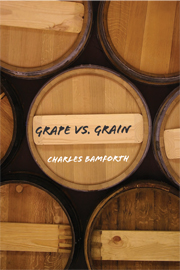Book contents
- Frontmatter
- Contents
- Preface
- Grape vs. Grain
- 1 Beer and Wine: Some Social Commentary
- 2 A Brief History of Wine
- 3 A Brief History of Beer
- 4 How Wine Is Made
- 5 How Beer Is Made
- 6 The Quality of Wine
- 7 The Quality of Beer
- 8 Types of Wine
- 9 Types of Beer
- 10 The Healthfulness of Wine and Beer
- 11 Conclusions about Beer and Wine – and the Future
- Further Reading
- Index
2 - A Brief History of Wine
Published online by Cambridge University Press: 16 September 2009
- Frontmatter
- Contents
- Preface
- Grape vs. Grain
- 1 Beer and Wine: Some Social Commentary
- 2 A Brief History of Wine
- 3 A Brief History of Beer
- 4 How Wine Is Made
- 5 How Beer Is Made
- 6 The Quality of Wine
- 7 The Quality of Beer
- 8 Types of Wine
- 9 Types of Beer
- 10 The Healthfulness of Wine and Beer
- 11 Conclusions about Beer and Wine – and the Future
- Further Reading
- Index
Summary
Noah was the first tiller of the soil. He planted a vineyard; and he drank of the wine, and became drunk …
Genesis 9:20To quench Noah's thirst God created the vine and revealed to him the means of converting its fruit into wine.
Benjamin FranklinIt is probable that wine was not the first alcoholic beverage enjoyed on this planet. Grain was a cultivated crop before grapes, and the work of the bee led to honey in the ancient forests at a very early stage. And so, the earliest beers and meads almost certainly pre-date wine.
Others suggest, however, that wine must have preceded beer because it is rather easier to make than is beer – a case of just crushing the grapes and allowing adventitious organisms on the surface of the berries to do their own thing. As a colleague of mine says, if you tread grapes you get wine; if you tread grain you get sore feet.
I facetiously tell my students that Jesus performed the miracle of converting water into wine because doing the trick of water to beer was far too technically demanding. The winemakers remind me that it was his first miracle.
Grain needs some degree of processing before it is ready for brewing, and yeast is not a native inhabitant of cereals and so would either need to be added to make beer or be present as a contaminant in a vessel.
- Type
- Chapter
- Information
- Grape vs. GrainA Historical, Technological, and Social Comparison of Wine and Beer, pp. 13 - 22Publisher: Cambridge University PressPrint publication year: 2008



